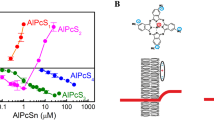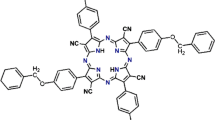Abstract
The mechanism of action of photosensitizers used in the photodynamic tumor therapy is studied by using bilayer lipid membranes (BLM) which adequately simulate the plasma membranes of cells. The formation of singlet oxygen upon photoexcitation of photosensitizer (tetrasulfonated alumophthalocyanine) is revealed by the photosensitizer-induced decomposition of styryl dyes di-4-ANEPPS or RH-421 the adsorption of which on BLM gives rise to changes in the dipole potential at the membrane interface. This potential decreases upon illumination of the membrane covered with adsorbed phthalocyanine and dye molecules as a result of the dye oxidation by singlet oxygen and is recovered upon interruption of illumination as a result of adsorption of new dye molecules from the solution. The changes in the potential are observed both when the dye molecules are adsorbed on the same (cis) membrane side as the photosensitizer molecules and also when they are adsorbed on the opposite (trans) membrane side. When the dye molecules are adsorbed on the trans side, the kinetics of potential variations in the light and its subsequent recovery in the dark depends on the membrane size. This dependence is explained within the framework of a model which assumes that dye molecules can get into the lipid bilayer not only from the aqueous solution but also as a result of lateral diffusion from the bilayer-surrounding circular reservoir containing a lipid solution in decane. The quantitative description of experimental data in terms of this model allows the coefficient of lateral diffusion of di-4- ANEPPS molecules in the lipid bilayer to be assessed as 10–7–10–6 cm2/s. The oxidation rate of dye molecules on the cis side is shown to be lower, which is explained by inhibition of the formation of singlet oxygen by dye molecules.
Similar content being viewed by others
References
O’Connor, A.E., Gallagher, W.M., and Byrne, A.T., Porphyrin and nonporphyrin photosensitizers in oncology: preclinical and clinical advances in photodynamic therapy, Photochem. Photobiol., 2009, vol. 85, p. 1053.
Stozhkova, I.N., Chernyi, V.V., Sokolov, V.S., and Ermakov, Yu.A., Adsorption of hematoporphyrins on a planar biological membrane, Biol. Membr., 1997, vol. 14, p. 310.
Rokitskaya, T.I., Antonenko, Y.N., and Kotova, E.A., The interaction of phthalocyanine with planar lipid bilayers: photodynamic inactivation of gramicidin channels, FEBS Letters, 1993, vol. 329, p. 332.
Stozhkova, I.N., Mirskii, V.M., Kayushina, R.L., Erokhin, V.V., and Mironov, A.F., Hematophorphyrin dimethyl ether interaction with artificial membrane systems. Double bonds of lipid hydrocarbon chains–the target of photodynamic damage of lipid membranes, Biol. Membr., 1992, vol. 9, p. 74.
Pashkovskaya, A.A., Sokolenko, E.A., Sokolov, V.S., Kotova, E.A., and Antonenko, Y.N., Photodynamic activity and binding of sulfonated metallophthalocyanines to phospholipid membranes: contribution of metal-phosphate coordination, Biochim. Biophys. Acta, 2007, vol. 1768, p. 2459.
Rokitskaya, T.I., Antonenko, Y.N., and Kotova, E.A., Photodynamic inactivation of gramicidin channels: a flash-photolysis study, Biochim. Biophys. Acta, 1996, vol. 1275, p. 221.
Sokolov, V.S., Block, M., Stozhkova, I.N., and Pohl, P., Membrane photopotential generation by interfacial differences in the turnover of a photodynamic reaction, Biophys. J, 2000, vol. 79, p. 2121.
Kunz, L. and Stark, G., Photodynamic membrane damage at the level of single ion channels, Biochim. Biophys. Acta, 1997, vol. 1327, p. 1.
Sokolov, V.S. and Pohl, P., Membrane transport of singlet oxygen monitored by dipole potential measurements, Biophys. J., 2009, vol. 96, pp. 77–85.
Loew, L.M., Scully, S., Simpson, L., and Waggoner, A.S., Evidence for a charge-shift electrochromic mechanism in a probe of membrane potential, Nature, 1979, vol. 281, p. 497.
Loew, L.M., Bonneville, G.W., and Surow, J., Charge shift optical probes of membrane potential. Theory, Biochemistry, 1978, vol. 17, p. 4065.
Malkov, D.Y. and Sokolov, V.S., Fluorescent styryl dyes of the RH series affect a potential drop on the membrane/solution boundary, Biochim. Biophys. Acta, 1996, vol. 1278, p. 197.
Sokolov, V.S., Gavrilchik, A.N., Kulagina, A.O., Meshkov, I.N., Pohl, P., and Gorbunova, Y.G., Voltage-sensitive styryl dyes as singlet oxygen targets on the surface of bilayer lipid membrane, J. Photochem. Photobiol, 2016, vol. 161, p. 162.
Sokolov, V.S. and Mirsky, V.M., in Ultrathin Electrochemical Chemo-and Biosensors: Technology and Performance, Mirsky, V.M., Ed., Springer, 2004, p. 255.
Ermakov, Yu.A. and Sokolov, V.S., in Planar Lipid Bilayers (BLMs) and their Applications, Tien, H.T. and Ottova-Leitmannova, A., Eds., Elsevier, 2003, p. 109.
Sokolov, V.S and Kuz’min, V.G., Measuring the potential difference of bilayer membranes by the second harmonics of capacitance current, Biofizika, 1980, vol. 25, p. 170.
Benz, R., Stark, G., Janko, K., and Lauger, P., Valinomycin-mediated ion transport through neutral lipid membranes: influence of hydrocarbon chain length and temperature, J. Membr. Biol., 1973, vol. 14, p. 339.
Hladky, S.B., The effect of stirring on the flux of carriers into black lipid membranes, Biochim. Biophys. Acta, 1973, vol. 307, p. 261.
Benz, R. and Janko, K., Voltage-induced capacitance relaxation of lipid bilayer membranes. Effects of membrane composition, Biochim. Biophys. Acta, 1976, vol. 455, p. 721.
Gaede, H.C. and Gawrisch, K., Lateral diffusion rates of lipid, water, and a hydrophobic drug in a multilamellar liposome, Biophys. J., 2003, vol. 85, p. 1734.
Kusba, J., Li, L., Gryczynski, I., Piszczek, G., Johnson, M., and Lakowicz, J.R., Lateral diffusion coefficients in membranes measured by resonance energy transfer and a new algorithm for diffusion in two dimensions, Biophys. J., 2002, vol. 82, p. 1358.
Author information
Authors and Affiliations
Corresponding author
Additional information
Original Russian Text © V.S. Sokolov, A.A. Shcherbakov, V.Yu. Tashkin, A.N. Gavril’chik, Yu.A. Chizmadzhev, P. Pohl, 2017, published in Elektrokhimiya, 2017, Vol. 53, No. 10, pp. 1321–1333.
This paper is the authors’ contribution to the special issue of Russian Journal of Electrochemistry dedicated to the 100th anniversary of the birth of the outstanding Soviet electrochemist Veniamin G. Levich.
Rights and permissions
About this article
Cite this article
Sokolov, V.S., Shcherbakov, A.A., Tashkin, V.Y. et al. Oxidation and lateral diffusion of styryl dyes on the surface of a bilayer lipid membrane. Russ J Electrochem 53, 1171–1181 (2017). https://doi.org/10.1134/S1023193517090130
Received:
Accepted:
Published:
Issue Date:
DOI: https://doi.org/10.1134/S1023193517090130




